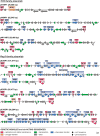Plasmids of Psychrotolerant Polaromonas spp. Isolated From Arctic and Antarctic Glaciers - Diversity and Role in Adaptation to Polar Environments
- PMID: 29967598
- PMCID: PMC6015842
- DOI: 10.3389/fmicb.2018.01285
Plasmids of Psychrotolerant Polaromonas spp. Isolated From Arctic and Antarctic Glaciers - Diversity and Role in Adaptation to Polar Environments
Abstract
Cold-active bacteria of the genus Polaromonas (class Betaproteobacteria) are important components of glacial microbiomes. In this study, extrachromosomal replicons of 26 psychrotolerant Polaromonas strains, isolated from Arctic and Antarctic glaciers, were identified, sequenced, and characterized. The plasmidome of these strains consists of 13 replicons, ranging in size from 3,378 to 101,077 bp. In silico sequence analyses identified the conserved backbones of these plasmids, composed of genes required for plasmid replication, stable maintenance, and conjugal transfer. Host range analysis revealed that all of the identified plasmids are narrow-host-range replicons, only able to replicate in bacteria of closely related genera (Polaromonas and Variovorax) of the Comamonadaceae family. Special attention was paid to the identification of plasmid auxiliary genetic information, which may contribute to the adaptation of bacteria to environmental conditions occurring in glaciers. Detailed analysis revealed the presence of genes encoding proteins potentially involved in (i) protection against reactive oxygen species, ultraviolet radiation, and low temperatures; (ii) transport and metabolism of organic compounds; (iii) transport of metal ions; and (iv) resistance to heavy metals. Some of the plasmids also carry genes required for the molecular assembly of iron-sulfur [Fe-S] clusters. Functional analysis of the predicted heavy metal resistance determinants demonstrated that their activity varies, depending on the host strain. This study provides the first molecular insight into the mobile DNA of Polaromonas spp. inhabiting polar glaciers. It has generated valuable data on the structure and properties of a pool of plasmids and highlighted their role in the biology of psychrotolerant Polaromonas strains and their adaptation to the environmental conditions of Arctic and Antarctic glaciers.
Keywords: Antarctica; Arctic; Polaromonas; bacterial adaptation; glacier; heavy metal resistance; iron–sulfur [Fe-S] cluster; plasmid.
Figures






Similar articles
-
Insight Into the Diversity and Possible Role of Plasmids in the Adaptation of Psychrotolerant and Metalotolerant Arthrobacter spp. to Extreme Antarctic Environments.Front Microbiol. 2018 Dec 18;9:3144. doi: 10.3389/fmicb.2018.03144. eCollection 2018. Front Microbiol. 2018. PMID: 30619210 Free PMC article.
-
Evidence of adaptation, niche separation and microevolution within the genus Polaromonas on Arctic and Antarctic glacial surfaces.Extremophiles. 2016 Jul;20(4):403-13. doi: 10.1007/s00792-016-0831-0. Epub 2016 Apr 20. Extremophiles. 2016. PMID: 27097637 Free PMC article.
-
Identification of miniature plasmids in psychrophilic Arctic bacteria of the genus Variovorax.FEMS Microbiol Ecol. 2016 Apr;92(4):fiw043. doi: 10.1093/femsec/fiw043. Epub 2016 Feb 24. FEMS Microbiol Ecol. 2016. PMID: 26917781
-
Plasmids of psychrophilic and psychrotolerant bacteria and their role in adaptation to cold environments.Front Microbiol. 2014 Nov 6;5:596. doi: 10.3389/fmicb.2014.00596. eCollection 2014. Front Microbiol. 2014. PMID: 25426110 Free PMC article.
-
Plasmidome of Listeria spp.-The repA-Family Business.Int J Mol Sci. 2021 Sep 25;22(19):10320. doi: 10.3390/ijms221910320. Int J Mol Sci. 2021. PMID: 34638661 Free PMC article.
Cited by
-
Insight Into the Diversity and Possible Role of Plasmids in the Adaptation of Psychrotolerant and Metalotolerant Arthrobacter spp. to Extreme Antarctic Environments.Front Microbiol. 2018 Dec 18;9:3144. doi: 10.3389/fmicb.2018.03144. eCollection 2018. Front Microbiol. 2018. PMID: 30619210 Free PMC article.
-
Landscape of the metaplasmidome of deep-sea hydrothermal vents located at Arctic Mid-Ocean Ridges in the Norwegian-Greenland Sea: ecological insights from comparative analysis of plasmid identification tools.FEMS Microbiol Ecol. 2024 Sep 14;100(10):fiae124. doi: 10.1093/femsec/fiae124. FEMS Microbiol Ecol. 2024. PMID: 39271469 Free PMC article.
-
Temperature Sensitivity and Composition of Nitrate-Reducing Microbiomes from a Full-Scale Woodchip Bioreactor Treating Agricultural Drainage Water.Microorganisms. 2021 Jun 18;9(6):1331. doi: 10.3390/microorganisms9061331. Microorganisms. 2021. PMID: 34207422 Free PMC article.
-
Assessing the Diversity and Metabolic Potential of Psychrotolerant Arsenic-Metabolizing Microorganisms From a Subarctic Peatland Used for Treatment of Mining-Affected Waters by Culture-Dependent and -Independent Techniques.Front Microbiol. 2021 Jul 6;12:648412. doi: 10.3389/fmicb.2021.648412. eCollection 2021. Front Microbiol. 2021. PMID: 34295311 Free PMC article.
-
The Zoige pioneer plant Leymus secalinus has different endophytic bacterial community structures to adapt to environmental conditions.PeerJ. 2023 May 18;11:e15363. doi: 10.7717/peerj.15363. eCollection 2023. PeerJ. 2023. PMID: 37220526 Free PMC article.
References
-
- Abou-Shanab R. A., Van Berkum P., Angle J. S. (2007). Heavy metal resistance and genotypic analysis of metal resistance genes in gram-positive and gram-negative bacteria present in Ni-rich serpentine soil and in the rhizosphere of Alyssum murale. Chemosphere 68 360–367. 10.1016/j.chemosphere.2006.12.051 - DOI - PubMed
LinkOut - more resources
Full Text Sources
Other Literature Sources
Molecular Biology Databases
Miscellaneous

